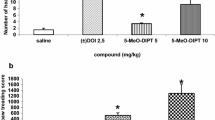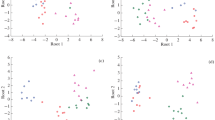Abstract
The MAO inhibitor phenelzine (PLZ) at a dose of 25 mg/kg does not affect the behavior of rats. In contrast, the equivalent dose of a deuterated analog (α,α,β,β-tetradeutero-PLZ, d4PLZ) elicits a biphasic behavioral syndrome in rats. In an attempt to correlate changes in cerebral monoamines with behavior, the concentration of various amines were measured at various times after the administration of either d4PLZ or PLZ (25 mg/kg). In general, PLZ and d4PLZ caused elevations in brain amine levels, particularly in the time period 2–12 hours after drug administration. Furthermore, d4PLZ increased the concentrations of serotonin (5-HT), phenylethylamine (PE), tryptamine (T),meta-tyramine (mTA), and 3-methoxytyramine (3-MT) to a greater extent than PLZ. Since the time course of behavioral excitation closely parallels the elevations in T and PE levels in the brain and since the percentage increases in PE and T levels following d4PLZ compared to PLZ treatment were substantially greater than those of the other amines, it was postulated that PE and T are involved in d4PLZ-induced behaviors.
Similar content being viewed by others
Abbreviations
- (PLZ):
-
Phenelzine
- (d4PLZ):
-
α,α,β,β-tetradeuterophenelzine
- (DA):
-
dopamine
- (NA):
-
noradrenaline
- (5-HT):
-
5-hydroxytryptamine
- (PE):
-
phenylethylamine
- (d4PE):
-
α,α,β,β-tetradeuterophenyl-ethylamine
- (pTA):
-
para-tyramine
- (mTA):
-
meta-tyramine
- (T):
-
tryptamine
- (3-MT):
-
3-methoxytyramine
References
Dourish, C. T., Boulton, A. A., and Dyck, L. E. 1982. Biphasic behavioral stimulation induced by a monoamiane oxidase inhibiting antidepressant. Prog. Neuropsychopharmacol. Biol. Psychiat. 6:383–388.
Dyck, L. E. 1984. The behavioral effects of phenelzine and phenylethylhydrazine may be due to amine release. Brain Res. Bull. 12:23–28.
Jacobs, B. L. 1976. An animal behavior model for studying central serotonergic synapses. Life Sci. 19:777–786.
Dourish, C. T., Dewar, K. M., Dyck, L. E., and Boulton, A. A. 1983. Potentiation of the behavioral effects of the antidepressant phenelzine by deuterium substitution. Psychopharmacology 81:122–125.
Dyck, L. E., Durden, D. A., Yu. P. H., Davis, B. A. and Boulton, A. A. 1983. Potentiation of the biochemical effects of β-phenylethylhydrazine by deuterium substitution. Biochem. Pharmacol. 32:1519–1522.
Davis, B. A., and Boulton, A. A. 1980. The metabolism of ingested deuterated β-phenylethylamine in a human male. Eur. J. Mass Spectrom. Biochem. Med. Environ. Res. 1:149–153.
Durden, D. A., Philips, S. R., and Boulton, A. A. 1973. Identification and distribution of β-phenylethylamien. Can. J. Biochem. 51:995–1002.
Philips, S. R., Durden, D. A., and Boulton, A. A. 1974a. Identification and distribution ofp-tyramine in the rate. Can. J. Biochem. 52:366–373.
Philips, S. R., Durden, D. A., and Boulton, A. A. 1974b. Identification and distribution of tryptamine in the rat. Can. J. Biochem. 52:447–451.
Philips, S. R., Davis, B. A., Durden, D. A., and Boulton, A. A. 1975. Identification and distribution ofm-tyramine in the rat. Can. J. Biochem. 53:65–69.
Kehr, W. 1976. 3-Methoxytyramine as an indicator of impulse-induced dopamine release in rat brain in vivo. Naunyn-Schmiedeberg's Arch. Pharmacol. 293:209–215.
Sloviter, R. S., Connor, J. D., and Drust, E. G. 1980. Serotonergic properties of β-phenylethylamine in rats. Neuropharmacology 19:1071–1074.
Dourish, C. T. 1981. Behavioral effects of acute and chronic β-phenylethylamine administration in the rat: Evidence for the involvement of 5-hydroxytryptamine. Neuropharmacology 20:1067–1072.
Marsden, C. A., and Curzon, G. 1978. The contribution of tryptamine to the behavioral effects of L-trytophan in tranylcypromine-treated rats. Psychopharmacology 57:71–76.
Dyck, L. E., and Dewar, K. M. 1986. Inhibition of aromatic L-amino acid decarboxylase and tyrosine aminotransferase by the monoamine oxidase inhibitor, phenelzine. J. Neurochem. 46:1899–1903.
Dyck, L. E., Durden, D. A., and Boulton, A. A. 1985. Formation of β-phenylethylamine from the antidepressant, β-phenylethylhydrazine. Biochem. Pharmacol. 34:1925–1929.
Baker, G. B., Legatt, D. F., and Coutts, R. T. 1982. Effects of acute and chronic administration of phenelzine on 2-phenylethylamine levels in rat brain. Proc. West. Pharmacol. Soc. 25:417–420.
Author information
Authors and Affiliations
Rights and permissions
About this article
Cite this article
Dewar, K.M., Dyck, L.E., Durden, D.A. et al. Involvement of brain trace amines in the behavioural effects of phenelzine. Neurochem Res 13, 113–119 (1988). https://doi.org/10.1007/BF00973322
Accepted:
Issue Date:
DOI: https://doi.org/10.1007/BF00973322




